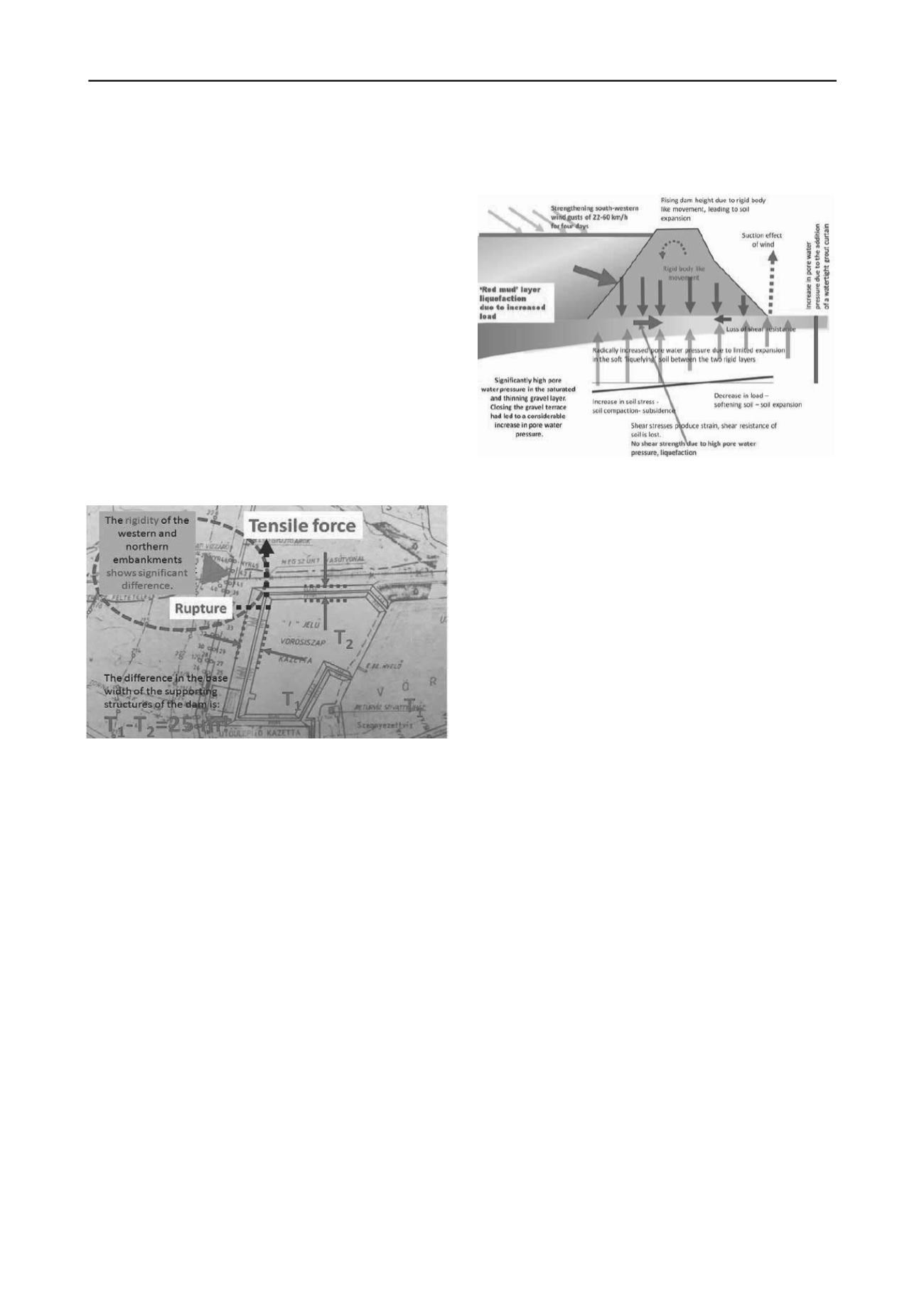
3312
Proceedings of the 18
th
International Conference on Soil Mechanics and Geotechnical Engineering, Paris 2013
construction of surface and subsurface structures. The northern,
so called intermediate embankment of Reservoir No. 10,
constructed in a smaller size with a view to the possible
extension of the reservoir system, served as an external, i.e.
boundary embankment. As a result, it was the surface run-off
and flow conditions that were first changed significantly by the
industrial use of the area in the stream valley.
It is also an important factor for the stability of the dam, that by
what kind of filling technology is used. In what magnitude and
distribution of water heights may occur within the area of the
reservoir?
It can be concluded that according to an engineering approach
to finding the causes, the failure of the rigid embankment of
large bearing capacity was a combined result of a number of
unfavourable conditions.
The base width of the northern embankment is significantly
different from the size of the other embankments, as it was
considered a temporary structure, bearing in mind the
possibility of a future extension. The slightly more than 20 m
height of the solid part of the embankment is lower than the 26–
27 m heights of the other embankments. Its effect manifested at
the northern embankment – being by 25 m less in base width
than the western embankment – as the resistance against
displacement here was significantly lower, and also because the
rigidity of the western and northern embankments showed
significant difference at an unfavourable connection at the
corner of the reservoir. (Figure 10.)
Fig.10. Summarizing some effects for the dam failure
The list of contributing factors could be further extended and it
will readily be conceived that it is the accumulation of
unfavourable conditions that led to the sudden rupture of the
embankment.
9. SUMMARY CONCLUSIONS
The present study aims to provide a background to a non-
exhaustive list of factors contributing to the embankment
failure, while attempting to give a clear picture of the complex
technical conditions.
The rupture of the embankment and the highly serious disaster
emerging thereof serve as a lesson in several aspects for
professionals performing technical or legislative tasks, as well
as for those working in the area of the administration of justice
and performing official control duties.
It is not an aim of the present study to identify scapegoats for
the incident.
Fig.10. Dimensions of the western and southern dams.
The geotechnical conditions were determined by the fact that at
the northern boundary embankment of the reservoir there are
beds of easily liquefiable muddy fine sand (or sand flour as
described earlier) in a layer of 3-4 m located in the closest
vicinity of the critical corner of the reservoir, adjacent to a
sandy-gravelly layer.
The findings and conclusions derived from the examinations
may be further refined and supplemented in the future in light of
further facts and data yet to be revealed.
Significant pore water pressure may have developed in the soil
layer underlying the embankment as a result of the geological
properties of the enclosed gravel terrace functioning as a
drainage basin and due to extremely high precipitation levels
causing high water pressure conditions.
The objective of the author of the present analysis is, led by
deep sympathy for the victims and those who suffered damage,
to provide an insight into the technical causes and the
circumstances of the tragic incident, as well as to promote, with
a humble approach to sciences, all endeavours to avoid such
disasters in the future.
9. REFERENCES
The increase of load on the slope surface of the embankment
might have contributed to the excess load – and the increase of
soil stress – in the subsoil on the inner side and as a
consequence, to excess subsidence, while it probably caused a
slighter rate of expansion on the outer side due to the rigid body
like movement of the embankment.
Asbóth, J. et al (1982) Geotechnical aspects of hydraulic spoil banks,
Civil Engineering Review, Volume XXXII, 12/1982, pp. 538-546.
Mecsi J. [2011]. “Red mud disaster - facts without comments- In
Collapse Understanding to Solution Book (In Hungaian),
Edited by:
J. Mecsi, Mérnöki Kamarai Kiskönyvtár 2nd edition ISBN 978-963-
88358-1-9, ISSN 2062-5081 pp. 159-166
The extremely rigid but light embankment and the soft,
liquefiable subsoil provided highly unfavourable static
conditions.
Mecsi, J. (2012) Expert opinion on the examination of the embankment
between Reservoirs No. 10 and 9) ME-SZI Engineering Expert
Office. József Mecsi, October 15, 2011. (In Hungarian.)
The liquefaction property and special thixotropic behaviour of
the “red mud” may have also contributed to the disaster.
Chemical effects, such as that of sodium hydroxide added to the
swollen clay in the course of the technological process, may
also have a role in the special behaviour of “red mud”.
Mecsi J. [2012]. “Engineering analysis of the Tragic Damage of a
Reservoir dam
16th International Conference on civil Engineering
and architecture Hungarian Technical Scientific Society of
Transylvania
,
ISSN 1843-2123 pp. 263-271 (In Hungarian)
The extremely unfavourable wind direction and wind speed
conditions may have given a final push toward the very sudden
embankment failure.


